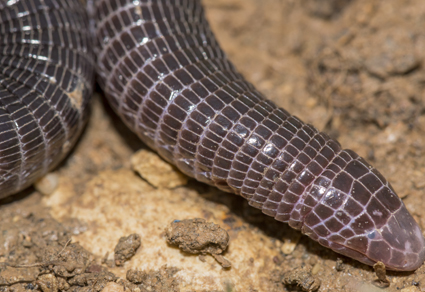Abstract
N/A
References
- Al-Barazengy, A.N., Salman, A.O. & Abdul Hameed, F.T. (2015) Updated list of amphibians and reptiles in Iraq 2014. Bulletin of the Iraq Natural History Museum, 13, 29–40.
- Albert, E.M. & Fernández, A. (2009) Evidence of cryptic speciation in a fossorial reptile: description of a new species of Blanus (Squamata: Amphisbaenia: Blanidae) from the Iberian Peninsula. Zootaxa, 2234 (1), 56–68. https://doi.org/10.11646/zootaxa.2234.1.4
- Albert, E.M., Zardoya, R. & García-París, M. (2007) Phylogeographical and speciation patterns in subterranean worm lizards of the genus Blanus (Amphisbaenia: Blanidae). Molecular Ecology, 16, 1519–1531. https://doi.org/10.1111/j.1365-294X.2007.03248.x
- Alexander, A.A. (1966) Taxonomy and variation of Blanus strauchi (Amphisbaenia, Reptilia). Copeia, 1966, 205–224. https://doi.org/10.2307/1441127
- Al-Jumaily, M.M. (1971) A new record of the Amphisbaenian Blanus bedraigai Boulenger in Iraq. Bulletin of the Biological Research Centre, Baghdad, 5, 83–84.
- Arévalo, E., Davis, S.K. & Sites, J.W. Jr. (1994) Mitochondrial DNA sequence and phylogenetic relationships among eight chromosome races of the Sceloporus grammicus complex (Phrynosomatidae) in central México. Systematic Biology, 43, 387–418. https://doi.org/10.1093/sysbio/43.3.387
- Clement, M., Posada, D. & Crandall, K.A. (2000) TCS: a computer program to estimate gene genealogies. Molecular Ecology, 9, 1657–1659. https://doi.org/10.1046/j.1365-294x.2000.01020.x
- Dufresnes, C. (2019) Amphibians of Europe, North Africa & the Middle East. A Photographic Guide. Bloomsbury Wild Life, London, 224 pp.
- Fritz, U., Hundsdörfer, A.K., Široký, P., Auer, M., Kami, H., Lehmann, J., Mazanaeva, L.F., Türkozan, O. & Wink, M. (2007) Phenotypic plasticity leads to incongruence between morphology-based taxonomy and genetic differentiation in western Palaearctic tortoises (Testudo graeca complex; Testudines, Testudinidae). Amphibia—Reptilia, 28, 97–121. https://doi.org/10.1163/156853807779799135
- Hall, T.A. (1999) BioEdit: a user-friendly biological sequence alignment editor and analysis program for Windows 95/98/NT. Nucleic Acids Symposium Series, 41, 95–98.
- Jablonski, D. & Sadek, R.A. (2019) The species identity and biogeography of Blanus (Amphisbaenia: Blanidae) in Lebanon. Zoology in the Middle East, 65, 208–214. https://doi.org/10.1080/09397140.2019.1604471
- Jablonski, D., Benovics, M., Vorel, J., Mohammed, S.I. & Afrasiab, S.R. (2020) The first record of the genus Microgecko Nikolskii, 1907 for Iraq. Herpetozoa, 33, 149–155. https://doi.org/10.3897/herpetozoa.33.e52736
- Jablonski, D., Ribeiro-Júnior, M.A., Meiri, S., Maza, E., Kukushkin, O.V., Chirikova, M., Pirosová, A., Jelić, D., Mikulíček, P. & Jandzík, D. (2021) Morphological and genetic differentiation in the anguid lizard Pseudopus apodus supports the existence of an endemic subspecies in the Levant. Vertebrate Zoology, 71, 175–200. https://doi.org/10.3897/vz.71.e60800
- Kornilios, P., Jablonski, D., Sadek, R.A., Kumlutaþ, Y., Olgun, K., Avcý, A. & Ilgaz, Ҫ. (2020) Multilocus species-delimitation in the Xerotyphlops vermicularis (Reptilia: Typhlopidae) species complex. Molecular Phylogenetics and Evolution, 152, 106922. https://doi.org/10.1016/j.ympev.2020.106922
- Lanfear, R., Frandsen, P.B., Wright, A.M., Senfeld, T. & Calcott, B. (2017) Partitionfinder 2: new methods for selecting partitioned models of evolution for molecular and morphological phylogenetic analyses. Molecular Biology and Evolution, 34, 772–773. https://doi.org/10.1093/molbev/msw260
- Leigh, J.W. & Bryant, D. (2015) Popart: full-feature software for haplotype network construction. Methods in Ecology and Evolution, 6, 1110–1116. https://doi.org/10.1111/2041-210X.12410
- Ronquist, F., Teslenko, M., van der Mark, P., Ayres, D.L., Darling, A., Höhna, S., Larget, B., Liu, L., Suchard, M.A. & Huelsenbeck, J.P. (2012) MrBayes 3.2: Efficient Bayesian phylogenetic inference and model choice across a large model space. Systematic Biology, 61, 539–542. https://doi.org/10.1093/sysbio/sys029
- Sindaco, R. & Jeremčenko, V.K. (2008) The reptiles of the Western Palearctic. Vol. 1. Edizioni Belvedere, Latina, 579 pp.
- Sindaco, R., Venchi, A., Grieco, C. (2013) The Reptiles of the Western Palearctic 2. Annotated checklist and distributional atlas of the snakes of Europe, North Africa, the Middle East and Central Asia, with an update to the vol. 1. Societas Herpetologica Italica, Via Adige, Latina, 543 pp.
- Sindaco, R., Kornilios, P., Sacchi, R. & Lymberakis, P. (2014) Taxonomic reassessment of Blanus strauchi (Bedriaga, 1884) (Squamata: Amphisbaenia: Blanidae), with the description of a new species from south-east Anatolia (Turkey). Zootaxa, 3795 (3), 311–326. https://doi.org/10.11646/zootaxa.3795.3.6
- Šmíd, J., Aghová, T., Velenská, D., Moravec, J., Balej, P., Naumov, B., Popgeorgiev, G., Üzum, N., Avcý, A. & Jablonski, D. (2021) Quaternary range dynamics and taxonomy of the Mediterranean collared dwarf racer, Platyceps collaris (Squamata: Colubridae). Zoological Journal of the Linnean Society, 193, 655–672. https://doi.org/10.1093/zoolinnean/zlaa151
- Şahin, M.K., Candan, K., Caynak, E.Y., Kumlutaş, Y. & Ilgaz, Ç. (2021) Ecological niche divergence contributes species differentiation in worm lizards (Blanus sp.) (Squamata: Amphisbaenia: Blanidae) in Mediterranean part of Anatolian peninsula and the Levantine region. Biologia, 76, 525–532. https://doi.org/10.2478/s11756-020-00548-1
- Stamatakis, A. (2014) RaxML version 8: a tool for phylogenetic analysis and post analysis of large phylogenies. Bioinformatics, 30, 1312–1313. https://doi.org/10.1093/bioinformatics/btu033
- Thompson, J.D., Higgins, D.G. & Gibson, T.J. (1994) Clustal W: improving the sensitivity of progressive multiple sequence alignment through sequence weighting, position-specific gap penalties and weight matrix choice. Nucleic Acids Research, 22, 4673–4680. https://doi.org/10.1093/nar/22.22.4673
- Townsend, T.M., Alegre, R.E., Kelley, S.T., Wiens, J.J. & Reeder, T.W. (2008) Rapid development of multiple nuclear loci for phylogenetic analysis using genomic resources: an example from squamate reptiles. Molecular Phylogenetics and Evolution, 47, 129–142. https://doi.org/10.1016/j.ympev.2008.01.008
- Vaissi, S. (2021) Potential changes in the distributions of Near Eastern fire salamander (Salamandra infraimmaculata) in response to historical, recent and future climate change in the Near and Middle East: Implication for conservation and management. Global Ecology and Conservation, 29, e01730. https://doi.org/10.1016/j.gecco.2021.e01730


